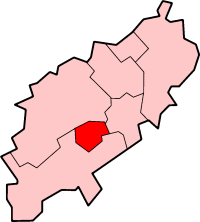| Revision as of 12:34, 7 March 2004 editMorwen (talk | contribs)Administrators56,992 editsNo edit summary← Previous edit | Revision as of 19:28, 7 March 2004 edit undoG-Man (talk | contribs)17,693 edits mentioning sportNext edit → | ||
| Line 16: | Line 16: | ||
| Nearby to Northampton is ], the country estate where ] is buried. | Nearby to Northampton is ], the country estate where ] is buried. | ||
| The town is home to a succesful ] club ] and a ] ] club ]. | |||
| ==History== | ==History== | ||
Revision as of 19:28, 7 March 2004
This article is about Northampton, England. For other places, see Northampton (disambiguation)
| Northampton
| |
 |
Northampton is a market town in central England upon the River Nene. It is the county town of Northamptonshire. Northampton has a population of 194,477 (2001 census), and is the largest district in England not to be a unitary authority.
Northampton is traditionally a major centre of shoemaking and other leather related industries. Although shoemaking is still important, it has been overtaken as the main industry by engineering, (bearings, vehicle components) distribution and fianance.
Of Northampton's most famous sons, Francis Crick the scientist who along with James Watson discovered the structure of DNA, was born in the town in 1916.
Northampton is served by the M1 motorway and the A45 road. By rail it is served by the West Coast Main Line, and has regular services to London and Birmingham. The regional airport for Northampton is the Sywell airport.
Nearby to Northampton is Althorp, the country estate where Diana, Princess of Wales is buried.
The town is home to a succesful Rugby football club Northampton R.F.C and a third division soccer club Northampton Town F.C..
History
Remains have been found in the Northampton area dating back to Roman times.
It is believed that farming settlement began in the Northampton area in around the 7th century. By the 8th century it had became an administrative centre for the kingdom of Mercia.
The town became significant in the 11th century, when the Normans built town walls and a large castle in Northampton.
In 1460, during the Wars of the Roses King Henry VI was captured in Northampton by Yorkists.
Northampton supported the parliamentarians during the English Civil War. For this reason the town walls and castle were later torn down on the orders of King Charles II as punishment. The railway station in Northampton stands on the site of the former castle, and for this reason is known as "Northampton Castle Station".
The town was destroyed by fire in 1675, and was re-built as a spacious and well-planned town.
In the 18th century Northampton became a major centre of footwear and leather manufacture. The prosperity of the town was greatly aided by demand for footwear caused by the many wars that took place in the 18th century.
Northampton's growth was accelerated in the 19th century by first the Grand Union Canal which reached the town in 1815. and later the coming of the Railways in the 1830s. A loop of the major West Coast Main Line was built into Northampton in the 1870s.
Population growth in Northampton by year
- 7,000 (1801)
- 33,000 (1861)
- 100,000 (1961)
- 200,000 (2001)
In the 19th century Northampton accuired a reputation for political radicalism when the radical non-conformist Charles Bradlaugh was elected on several occasions as the towns MP.
In the 1960s the town was designated a new town and the population grew rapidly due to new housing developments. The town also became linked to the M1 motorway.
External Link
| Districts of the East Midlands region of England | ||
|---|---|---|
| Derbyshire |  | |
| Leicestershire | ||
| Lincolnshire | ||
| Nottinghamshire | ||
| Northamptonshire | ||
| Rutland | Rutland | |